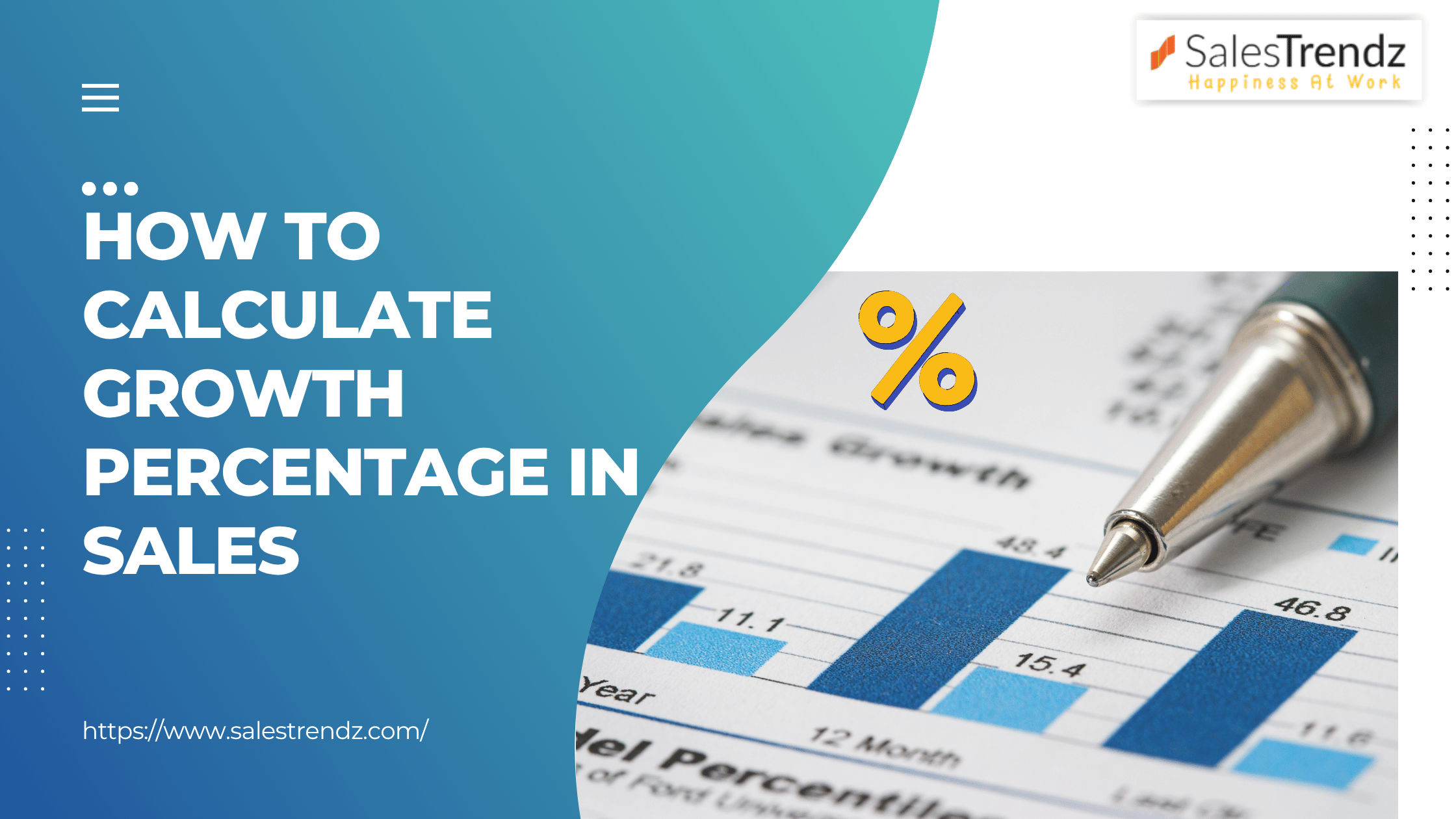How to Calculate Growth Percentage in Sales?

“Sales growth percentage is a KPI used to measure how much your sales revenue has increased (or decreased) over a period of time.”
Not sure if your sales are actually growing month by month or just staying flat?
Understanding your sales growth percentage is one of the most powerful metrics for evaluating your business performance. Whether you’re a founder, sales leader, or analyst, knowing how to calculate growth percentage — and what it means — can drive smarter decisions.
In this post, we’ll break down how to calculate Month-on-Month (MoM) and Year-on-Year (YoY) sales growth using simple formulas, real-life examples, and free downloadable tools.
We’ll also show you how SalesTrendz dashboards can help you visualize growth in real-time, spot trends early, and stay ahead of targets.
Basic Sales Growth Formula Explained
The basic sales growth formula is straightforward:
Sales Growth (%) = [(Current Period Sales – Previous Period Sales) / Previous Period Sales] × 100
This gives you the percentage increase or decrease over time. You can apply it monthly, quarterly, or annually depending on your reporting needs.
How to Calculate Month-on-Month (MoM) Sales Growth
Month-on-Month growth shows the percentage change in sales from one month to the next. It’s perfect for short-term analysis or campaign performance tracking.
MoM Sales Growth Formula:
MoM Growth (%) = [(Sales This Month – Sales Last Month) / Sales Last Month] × 100
Example:
- Sales in May: $80,000
- Sales in April: $70,000
MoM Growth = [(80,000 – 70,000) / 70,000] × 100 = 14.3%
Your business grew by 14.3% compared to the previous month. Nice job!
How to Calculate Year-on-Year (YoY) Sales Growth
Year-on-Year growth compares sales for a specific month or quarter this year with the same period last year. It’s ideal for spotting longer-term trends and evaluating your overall strategy.
YoY Sales Growth Formula:
YoY Growth (%) = [(Sales This Year – Sales Last Year) / Sales Last Year] × 100
Example:
- Sales in Q1 2025: $250,000
- Sales in Q1 2024: $200,000
YoY Growth = [(250,000 – 200,000) / 200,000] × 100 = 25%
That’s a 25% growth over the year — solid progress!
Visualizing Sales Growth with Charts
Let’s look at a line chart to see how your sales grow over six months:

A steady upward trend like this signals healthy, consistent growth. Spikes or dips help identify the impact of campaigns, seasons, or external events.
Common Mistakes When Calculating Sales Growth
Before you go diving into your spreadsheets, here are a few mistakes to avoid:
- Comparing different durations: Always compare full periods (e.g., full months or quarters).
- Not adjusting for inflation or pricing changes: Revenue growth isn’t always due to more customers.
- Ignoring churn or cancellations: Gross sales may increase, but net sales tell the real story.
- Not using consistent currency or units: Especially in multinational teams or regions.
Excel vs. Real-Time Dashboards: Which Should You Use?
Manual Growth Tracking:
You could open up Excel, input sales data every month, and apply the formulas. But let’s be honest — this method is:
- Time-consuming
- Error-prone
- Lacking in real-time insights
SalesTrendz Growth Dashboards:
With SalesTrendz, you don’t have to calculate manually. Our real-time performance dashboard displays:
- MoM and YoY growth metrics
- Interactive graphs and charts
- Team-level or product-level trends
- Forecasted growth using AI
You’ll instantly know whether you’re on track — no formulas, no lag, no guesswork.
Using Sales Growth to Drive Decisions
So, what do you actually do with sales growth data?
Set Goals: Align growth targets with past performance.
Reward Your Team: Recognize which reps or regions contributed most to growth.
Refine Campaigns: See what marketing efforts correlated with sales spikes.
Forecast Future Performance: Project revenue trends and identify future dips before they happen.
You can use SalesTrendz’s predictive dashboard to run growth simulations based on historical data.
Benchmarks: What’s a Good Growth Percentage?
This depends on your industry, but here’s a quick guide:
| Industry | Healthy MoM Growth | Healthy YoY Growth |
| SaaS | 10–20% | 40–60% |
| Retail | 3–10% | 10–25% |
| Manufacturing | 2–8% | 8–15% |
| B2B Services | 5–12% | 20–30% |
Your target should reflect your business maturity, market, and resources. New startups often see rapid early growth, while mature firms aim for stability.
The key is to turn Growth Data into Growth Action!
Knowing how to calculate sales growth is only the beginning. The real power lies in the way how you utilize that data.
With SalesTrendz, you get more than just a formula — you get insights, strategy, and foresight. Track your growth month by month or year by year, visualize trends with clarity, and make decisions that actually move the needle.
With SalesTrendz CRM, you can automate targeted email campaigns based on where leads are in your sales pipeline and how they’re segmented. The platform makes it easy to engage prospects through email, SMS, or WhatsApp, triggered by actions like visiting specific web pages, submitting inquiry forms, or interacting with ads — ensuring timely and relevant communication every step of the way.
Ready to Grow Smarter?
Explore SalesTrendz Analytics Dashboards — designed to turn your data into opportunity.
Start your free trial today — No credit card needed!


